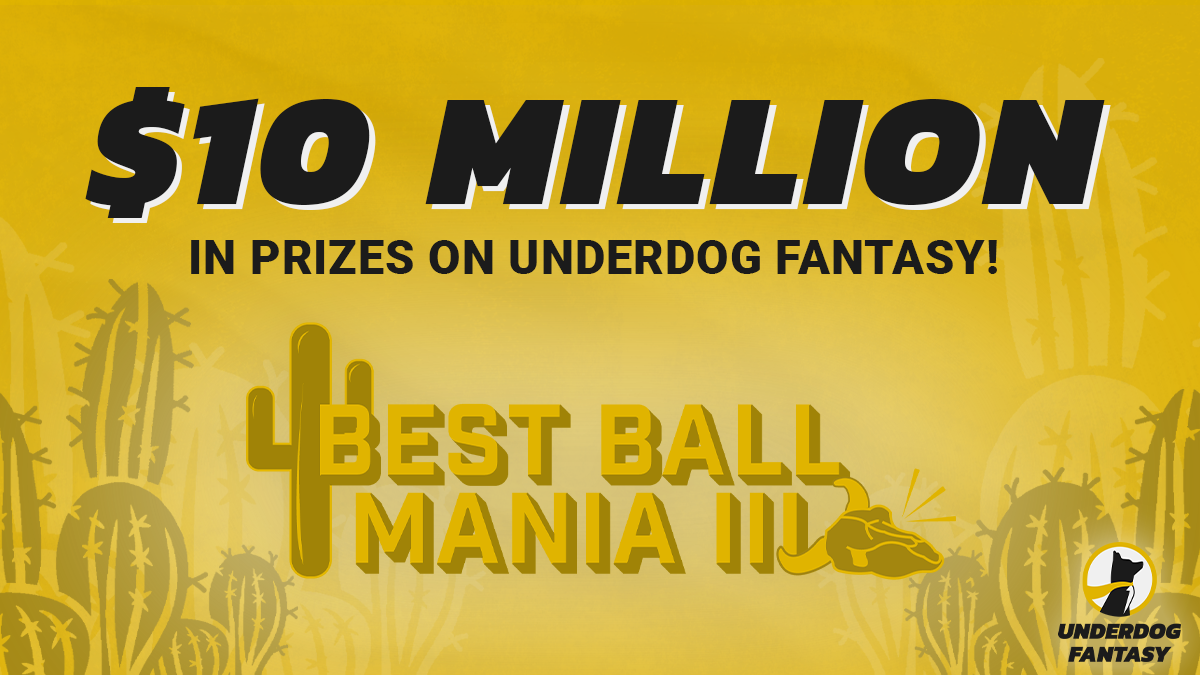 Draft With Us On Underdog! Use Promo-Code: YARDSPER for a 100% deposit match up to $100!
Draft With Us On Underdog! Use Promo-Code: YARDSPER for a 100% deposit match up to $100!
My good friend @CoachBruce122 made a statement recently about running back handcuffs that I thought was a fairly well understood concept. Based on the responses he received, I’m not sure it was. I articulated a couple of my thoughts in the replies too but you can only get so much across in 280 characters (I’m over 300 already here!) so I decided to address it in longer form.
The concept: If you’re going to handcuff a running back, don’t handcuff the RB1 on your team, handcuff someone else’s running back.
Firstly for anyone who isn’t familiar with the idea, ‘handcuffing’ is the principle of having a backup on your team so that if the starter misses time, the backup (or ‘handcuff’) walks in to a much greater workload and you don’t have to fight your teammates to pick them up off waivers. For example, you hold Vikings running back Alexander Mattison on your bench and if Dalvin Cook misses time, you have the starting running back at a much much cheaper price than Dalvin Cook would have been.
The case for Handcuffing your own Running Back
It’s a simple one. If your prize running back gets injured (or misses time for any other reason), you have the guy who gets that similar volume and your investment is somewhat protected. You aren’t all of a sudden going to lose huge production from your team. In theory.
The case for Handcuffing someone else’s Running Back
The short statement here is that it’s a ceiling play. That is, if the starting running back misses time you still have your prize running back and now also have another potential star to add to your team. Your scoring potential increases.
How else can we look at this?
I’ve got a few different thoughts on how to phrase this so I’ll try them all to see if any of them resonate better than others.
The case for the Ceiling
If your own running back goes down and you have your own handcuff, you guarantee 80-percent of the production (if you’re lucky). Your floor is protected, you’ll always get the 80-percent production as a minimum. In your range of outcomes, the floor is 80-percent but the ceiling will never be more than 100-percent.
However, if someone else’s running back goes down and you have their handcuff, you have the 80-percent from that handcuff in addition to the 100-percent of your own running back. Your ceiling becomes 180-percent.
Lets lay the numbers out and lets use 20 as an arbitrary number for RB1 production, 10 as a number for your RB2, and we’ll assume the handcuff gives you somewhere in the middle with 15. The standard baseline for your two RBs (without injury) is 20 + 10 = 30.

Scenario 1
Your RB1 goes down but you have your own handcuff
RB1 = 15
RB2 = 10
Total = 25
Your opponent’s team is unchanged, they have a score of 30 and therefore stand a better chance of winning than you do but only by 5 points.
Scenario 2
Your opponent’s RB1 goes down and you have their handcuff
RB1 = 20
RB2 = 15
Total = 35
Opponent:
RB1 = 10 (replacement RB2)
RB2 = 10
Total = 20
You now have a 15 point advantage on your opponent, putting you in a much better chance of winning.
That’s what we’re talking about when we talk about this being a ceiling play.
But what if your RB goes down and you don’t have the handcuff? Well you’re in the same position as your opponent in scenario 2 above, you’re headed for 20 points. Yes, that’s a worse position than you would have been in if you’d got your handcuff, but either way you’re at a disadvantage the minute your prize running back misses time.
Why not the Floor?
If you’re in a 10-team league and we assume all things being equal (all leaguemates are similarly awesome at fantasy football and no one team has an advantage over others), you have a 10-percent chance of winning your league.
Within that 10-percent is the understanding that, in theory, every team’s 1st round pick is going to score more of the points than the other picks (otherwise why would you draft them 1st?).
So the minute your 1st round running back goes down, every other team in the league has an advantage over you. Your chances of winning have just gone from 10-percent to say 6-percent and every other team’s chances of winning have just ticked up so the gap between you and your opponents has gone from 0 to significant.
Put it this way, I’d wager that in most redraft leagues in the last two seasons the manager who drafted Christian McCaffrey didn’t win the league.
Now if you have the handcuff, you’re bolstering your chances for sure. Your chances of winning might go back up from 6-percent to 8-percent. But they’re still lower no matter what and, again assuming all things equal, your leaguemates are still going to beat you – they’re just going to beat you by less.
Having your handcuff essentially means you’ll lose by less.
If you actually think about it for a bit longer, if you have one of the elite few running backs then the difference is even bigger. Why? Because you drafted them in the top 2 or 3 picks and, assuming you did a snake draft, your 2nd round pick is a lower value than most of your opponent’s 2nd round picks. You’re relying on your elite running back to score an even bigger portion of your points to make up for that drop in value in round two. So the minute you lose that player, that gap becomes a chasm. At that point, you need a miracle, not a handcuff.
You might see yourself as a fantasy manager that can overcome these things and still win. That’s great, good for you. What that really means is that you were going to win the league by miles anyway and this just makes it a little harder, in which case you probably don’t need to handcuff regardless.
You might also see this as just a luck thing, and to some extent it is. If your RB1 goes down you’re unlucky, if your opponent’s RB1 goes down you’re lucky, and if you happen to have the right handcuff for whoever gets injured then you’re super lucky. Fantasy football has a massive slice of luck involved and if you’re on the wrong side of that luck then it might not matter what you do.
But what you can do is look at the probabilities. You need some good luck to go your way but you also need to put yourself in the best position to take advantage of that luck. You don’t win your league by having a bunch of average players, you win it by having your top players perform well and a few diamonds to get you over the top.
If you have your own handcuff and your running back goes down, your top players aren’t performing and your diamond is actually just a rock: you probably aren’t going to win anyway, you’re just going to lose by less. If you have another handcuff and the starter goes down, you still have your top performers and you now have that diamond you need to get you over the top.
To win your league, you need your top draft picks to perform to expectation AND you need some diamonds to give you the extra edge – when you have your own handcuff, it’s not possible to have both of these at the same time.
While we’re talking about diamonds, lets also talk about opportunity cost. We need to find a couple of diamonds to help us win our league and it’s incredibly difficult to know who those diamonds are going to be. The best way to find them then is to take multiple shots at finding them – the more the better. I’ve noted above that your own handcuff will never be a diamond because they will never improve your team from where it is at the start. So if you’re holding your handcuff on your bench, that’s one less shot of finding those diamonds.
How about a crude money-based analogy?
Lets say an RB1 is worth $100, an RB2 is worth $50 and a handcuff who gets the gig is worth $75.
With your own handcuff, you end up with $75 + $50 = $125
With another handcuff, you end up with $100 + $75 = $175
Remember that your opponents all have $150 potential and there’s 9 of them (or more depending on league size of course). Which one do you want? What about if there’s a $500 bonus for the winner? Do you still want the one that’s going to help you lose by less or do you want the one that could put you over the top?
Horses for courses
It’s worth pointing out that there’s always going to be different cases and scenarios for drafting different players and this is not a one-size fits all strategy. It also depends on the players and their quality: you wouldn’t usually draft a lower quality player just because they’re a handcuff of your opponent. You’ll still draft better players over lesser players.
It also depends on what you really define as a handcuff. There are the pure handcuffs of the world like Alexander Mattison who basically have no standalone value, and there are the handcuff-plus players like Kareem Hunt or AJ Dillon who have some standalone value as a flex but would walk in to monster roles if the starter went down. The opportunity cost of drafting the handcuff-plus players is much higher and you’re potentially taking a downgrade compared to other players available in that range, but the ceiling is much higher if that starter ever goes down. In that scenario, the floors and ceilings of every possible scenario go up significantly but the principles are similar and you have to pay a much higher price for that ‘handcuff’.
You do you
All this said, it’s your fantasy team and you do you. If you’re the kind of fantasy manager that wants an insurance policy that pays out 80-percent and you believe that gives you enough of a floor to try and win elsewhere then you go for it. But if you’re that confident in your ability to overcome the probabilities even if your 1st round pick is missing, then maybe you don’t need to handcuff anyway.







